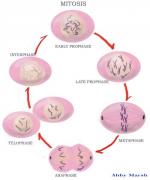|
This section contains 1,609 words (approx. 6 pages at 300 words per page) |

|
Overview
Cell theory, the cornerstone of biology, states in modern form that (1) living matter is composed of cells; (2) chemical reaction takes place within cells; (3) cells arise from other cells; and (4) cells have information that is passed from parent to daughter cells. In the nineteenth century three scientists advanced the knowledge of cell division and mitosis. German botanist Hugo von Mohl (1805-1872), using improved microscopic techniques, studied cell division in algae and determined that cells divide. German biologist Walther Flemming (1843-1905) applied aniline dyes to observe the processes of cell division in the nucleus and how chromosomes behave. Belgian zoologist Edouard van Beneden (1846-1910) first described the process of fertilization and stages of embryonic division.
 An early illustration of cell division by Hugo von Mohl (1839).
An early illustration of cell division by Hugo von Mohl (1839).
Background
At the beginning of the nineteenth century, scientists knew nothing about the existence of cells. When they...
|
This section contains 1,609 words (approx. 6 pages at 300 words per page) |

|


